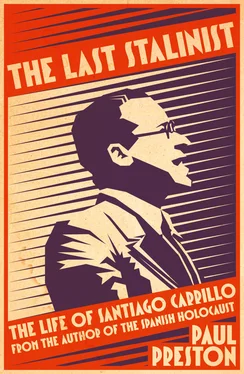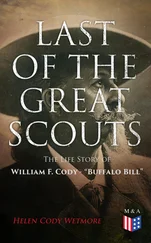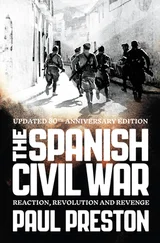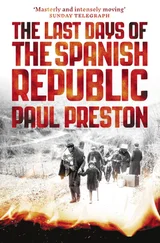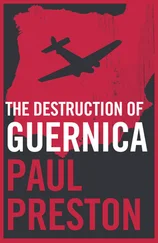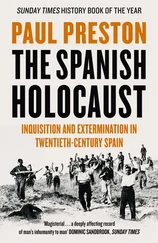He admitted later that the fusion with the UJC was merely the opening step of a project to take first the FJS and then the entire Socialist movement into the Communist International. In his submission to the KIM, he declared that the maintenance of the organizational structure of the Socialist Youth was a necessary interim measure dictated by the need first to complete the purging of the PSOE. This trip inevitably had a crucial influence on his subsequent development. The KIM, with its headquarters in Moscow, was closely invigilated by the Russian intelligence service, the NKVD (the People’s Commissariat for Internal Affairs), and Soviet Military Intelligence (Glavnoe Razvedupravlenie, or GRU). Having been identified by Codovila as a potential Comintern star, Carrillo would have been vetted anyway, but the process was probably more rigorous because of suspicions of his Trotskyist leanings reported by ‘fat Carmen’. 48Like all prospective Comintern leaders, Carrillo would have been obliged to convince his Moscow bosses, particularly the hard-line Stalinist Farkas/Wolf, that he would fully collaborate with the Soviet security services. 49It seems to have been no hardship. Seduced by Dimitrov, Manuilsky and other heroes, the young man who had presumed to argue that the FJS should dictate Socialist strategy would happily accept the diktats of the Kremlin. His first lesson was to accept that Trotsky was a traitor. The second was that the mission of a united youth movement was not to forge an elite revolutionary vanguard but to recruit a mass youth organization.
Even though it had been long coming, Carrillo’s change of position was breathtaking. He had played a significant part in encouraging the capricious and vacuous revolutionary rhetoric of Largo Caballero that had contributed to the disaster of October 1934. He had been a central figure in the project to bolshevize the PSOE and had done significant damage to the moderate and more realistic wings of the Socialist movement. Gil Robles and Salazar Alonso knew that Largo Caballero’s revolutionary threats were meaningless. In contrast, the insistent demands of Carrillo and the FJS leadership in Renovación for the conquest of power and the dictatorship of the proletariat can only have terrified moderates on the Spanish right and played into the hands of the conspiratorial extremists. The same can be said about Octubre: segunda etapa . Yet now he put all that behind him without apology or regret. He used to say in later life, ‘Repentence does not exist.’ Having contributed to the intensification of hatreds in Spain and thus weakened the Republic, he had now initiated a process that would mortally wound the party of his father and his patron. In doing so, he demonstrated a poisonous cocktail of vaulting ambition, supreme self-confidence and irresponsibility.
After the Civil War Carlos de Baraibar commented bitterly on the manic enthusiasm of Carrillo and Melchor for everything they had seen in the Soviet Union. On their return, ‘they spoke extravagantly about the people, their achievements, their laboratories and even their toilets’. He believed that, in a sense, they had been corrupted by the experience. ‘In Moscow,’ he wrote,
they, like many simple souls before them, had found their road to Damascus and, on their return, began to sketch wild plans for the reorganization of the youth movement that signified the undermining of its revolutionary essence. They brought back with them a confused mixture of totalitarian illusions of recruiting the entire young population of Spain, ambition to create a colossal organization and sheer village idiocy. They were seduced by the bewildering panoply of figures, tables and statistics cleverly put before them. 50
Shortly after Carrillo’s return to Madrid, a joint meeting was held of the FJS and UJC executive committees to consider the report that the delegation had elaborated in Moscow in favour of a new mass united movement. The report was approved as the basis for unification and a joint national committee set up to implement the fusion process. Much effort had been made to combat suspicions that the Socialist movement was about to lose its youth movement to the Communists. Rather, it was hoped to reassure Largo Caballero that the UJC would be absorbed into the FJS. However, in practice, as could have been anticipated, that was not what happened, given Carrillo’s ever closer links to Moscow. Public meetings were held in local sections of both organizations to propagate the unification. They culminated in a mass gathering at the Las Ventas bull-ring in Madrid on Sunday 5 April 1936. In his speech on that occasion, Carrillo declared that what was happening repaired the schism of 1921 which had seen the radical wing of the PSOE depart to form the PCE. The event at Las Ventas was followed throughout May and July 1936 by meetings of the provincial sections of the FJS and UJC to prepare for a great national conference of unification which, because of the outbreak of civil war, never took place. In those months, the joint membership of 100,000 was swollen to 140,000. 51
Retrospectively, Largo Caballero recalled his reaction in similar terms to those of Baraibar. He claimed that when Carrillo and others came to explain the proposed organizational plans, he told them that their plans for a mass youth movement undermined the purpose of the FJS as an elite training school for future PSOE leaders. He declared uncompromisingly that he now considered the FJS to be dead and, with it, the hope that it would be a bulwark for the Socialist Party. Carrillo tried to convince him of his good faith and his loyalty. He made ‘a solemn promise that he would create a formidable organization that was totally socialist’. 52
Amaro del Rosal, who was one of those present when Largo Caballero was informed of the unification, recalled his distress: ‘his eyes filled with tears’. Carrillo had effectively delivered a shattering blow to the PSOE, undermining its political future. As Largo Caballero perceived, he was delivering to the PCE, in the words of Helen Graham, ‘a political vanguard which undoubtedly included many potential national and provincial leaders’. There were those, Serrano Poncela among them, who were alarmed that Carrillo now talked of creating a mass organization contrary to the traditional perception of the FJS as an elite training ground for the PSOE. Although Carrillo made a speech in which he paid tribute to Largo Caballero, the damage had been done. 53
Carrillo took part in a meeting of the Communist Party Central Committee on 31 March, at which he suggested that the new JSU, the Juventudes Socialistas Unificadas, should seek membership of the KIM and that the PSOE should unite with the PCE and join the Comintern. Attendance at Central Committee meetings was a privilege not normally extended to outsiders. 54Carrillo would not formally join the Communist Party for another six months, but there is reason to believe that he was already a Communist in all but name. In 1974, he admitted that, on his return from Moscow, ‘I had begun to become a Communist. I did not join the Party immediately, although I began to collaborate with the Communists and was even invited to take part in meetings of the Central Committee. I had not yet joined because I was still hopeful of bringing about the unification of the Socialist and Communist parties.’ 55
The procedure whereby the new executive committee of the JSU was appointed in September 1936 was extremely opaque. There were fifteen members, of whom seven were Communists, although several of the eight Socialists were so close to the PCE as made little difference. Carrillo became secretary general of an organization that, despite its name, constituted a massive advance of Communist influence. 56Those who perceived the creation of the Juventudes Socialistas Unificadas as the loss of the FJS to the Third International coined the nickname ‘Juventudes Socialistas Urssificadas’ (USSR in Spanish being URSS). 57
Читать дальше
